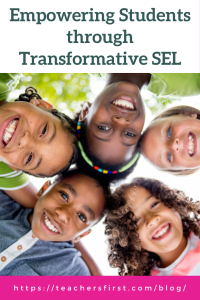“SEL is the universal life jacket, keeping students afloat and open to learning. Only when children learn in psychologically safe environments that nurture their emotion skills can they move from helplessness to resilience, from anxiety to action, from scattered to centered, from isolated to connected.”
– Marc Brackett, Ph.D.
Social and emotional learning (SEL) can empower learners by helping them develop emotional resilience skills. These skills can help students better understand and manage their own emotions, as well as to recognize and respond to the emotions of others. It’s important for educators and caregivers to provide support and resources to mitigate the impact the COVID-19 pandemic has had on students.
According to the Collaborative for Academic, Social, and Emotional Learning (CASEL), social and emotional learning (SEL) is an integral part of education and human development. SEL is the process through which all young people and adults acquire and apply the knowledge, skills, and attitudes to develop healthy identities, manage emotions and achieve personal and collective goals, feel and show empathy for others, establish and maintain supportive relationships, and make responsible and caring decisions.
Furthermore, SEL has the potential to advance educational equity by addressing the social and emotional needs of all students and helping to create a more inclusive and supportive learning environment.
CASEL, in recent years, has refined a specific form of SEL implementation that goes beyond just teaching students skills and strategies, but aims to transform individuals, communities, and systems to create more equitable and just societies. This implementation is referred to as “Transformative SEL.”
According to Jagers et al., several key focal constructs are important for transformative social and emotional learning (SEL). These include:
- Identity is a key component of self-awareness and refers to how individuals view themselves, including their values, beliefs, and unique characteristics.
- Agency, or the ability to take purposeful action, is critical to self-management and can involve making choices about learning and career goals, overcoming challenges, and participating in collaborative problem-solving.
- Belonging, or the feeling of acceptance, respect, and inclusion within a group or community, is an important aspect of social awareness. It involves not only feeling recognized but also being actively involved in building relationships and creating inclusive learning environments.
- Collaborative problem solving is essential in the realm of relationship skills and involves working with others to identify and solve problems or achieve common goals. It requires strong communication skills, listening and considering others’ perspectives, and a willingness to work towards a common goal.
- Curiosity, or the desire to learn and explore new things, is a core aspect of responsible decision-making. It involves both cognitive and affective elements and can help individuals engage in critical thinking and take action based on their learning and experiences.
Here are some strategies that educators and caregivers can use that align with the transformative SEL focal constructs:
- Self-reflection and check-ins: Give students time to think about their feelings and actions and how they impact others. You can use web-based sites like Along (reviewed here) that provide ready-to-go reflection activities and digital check-in activities.
- Promote mindfulness: Help students to be present in the moment and to pay attention to their thoughts and emotions. For ideas on infusing mindfulness throughout your day, check out this TeachersFirst blog post.
- Encourage goal-setting: Help students to set goals for themselves and to develop a plan to achieve them.
- Promote positive self-talk: Help students recognize and challenge negative self-talk replacing it with positive and empowering thoughts. One resource for educators looking to build positive thinking skills and character development in the classroom is Thrively (reviewed here).
- Community-building activities: Engage students in activities that promote mutual respect, such as daily classroom meetings and engaging collaborative activities.
- Welcoming activities: Before starting class, try incorporating short routines and rituals so students can connect.
- Exploration opportunities: Encourage students to explore new topics and ideas and provide them with resources and support to do so. Explore these suggestions for encouraging curiosity in your classroom.
This is not an exhaustive list, and there are many other activities to support a positive and inclusive classroom climate. To find additional resources to incorporate SEL in your classroom, visit TeachersFirst’s collection of Social and Emotional Learning resources.
What SEL strategies and resources are you using to support and empower learners? We’d love to hear them in the comments below!



Thank you for the resources on how to incorporate SEL in the classroom. My district has spent this past school year building our own custom framework for SEL. The committee that worked on this used CASEL as a guide for creating this framework. I am looking forward to implementing a more structured SEL program in my classroom this year. The resources and activities you provided will definitely be helpful!